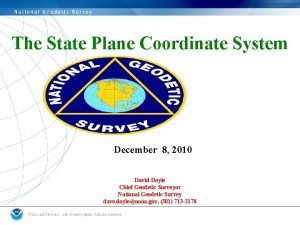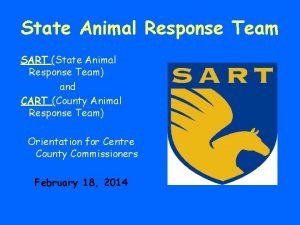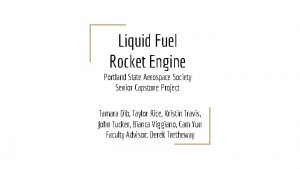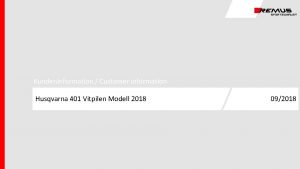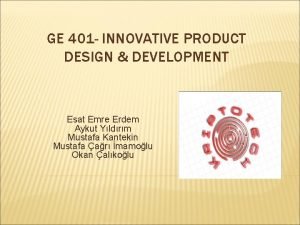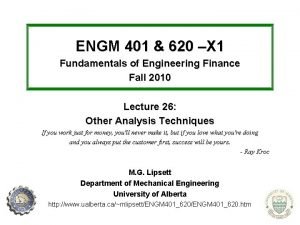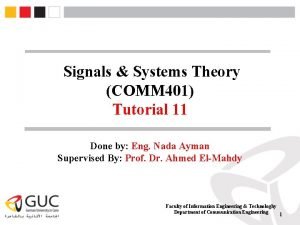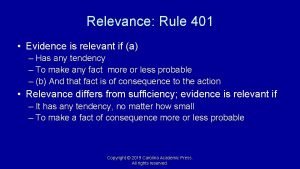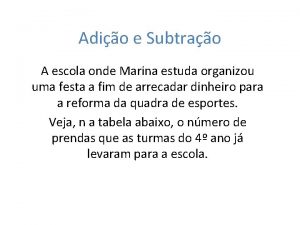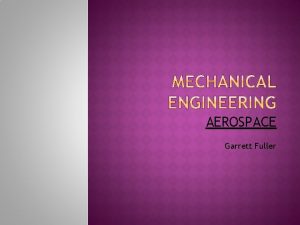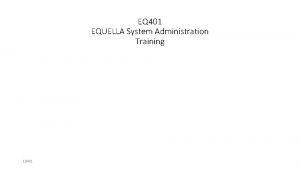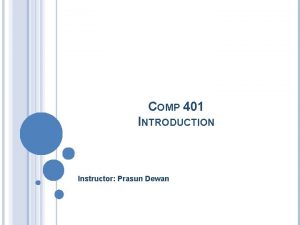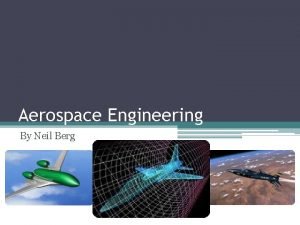The Pennsylvania State University Aerospace 401 ERV 4






















- Slides: 22

The Pennsylvania State University Aerospace 401 ERV 4 Fall 2003 Sean M. Barraclough Benjamin R. Eastmond Jessica E. Gatto Matthew F. Kauffmann Joel D. Richter Amber M. Wilson

ERV Configuration

Mission Architecture

Structures Cylindrical Design l Monolythic l Dampening l Docking Adaptor l Large Space Uses l l Food Storage l Computer and Communications Equipment l Entertainment

Structures l Friction Stir Welding l Aluminum Metal Matrix Composites l Magnum Launch Vehicle l 85, 000 kg l 2 launches

Propulsion l Liquid bipropellant system using CH 4 as fuel and O 2 as oxidizer l RD-0234 -CH = main engine located on lander T = 442 k. N; Isp = 343 sec; m = 390 kg l RD-183 = smaller engines used as thrusters T = 9. 80 k. N; Isp = 360 sec; m = 60 kg

Ground Control l Dedicated Ground System l l Co-located MCC, POCC, SOCC Combinations POCC and SOCC l Back-up Ground Station l Manned by minimum number of staff

Communications Deep Space Network l High Gain Antennae (HGA) l Two Low Gain Antennae (LGA) l Total Communications System l l l One HGA, 2 m diameter Two LGA, 0. 25 m diameter Receiver and transmitter, combined measuring 5 m by 2 m Total weight: 160 kg

Communications l Mars Reconnaissance Orbiter Earth/ Lander Launch 2005 DSN l Intermediary link between ERV Mars and DSN Recon l Guidance system to help ERV Communications Relay System when entering Mar’s orbit (when in Mars orbit) l Beacon System l Monitor overall health of ERV going to Mars l Sends out one of 4 carrier tones indicating ERV health l Easily detected, low cost, frees up space on DSN l Beacon System

Command Data Handling l Completely redundant, no single point failure l l Space Shuttle computers l l l Space Shuttle uses 5 computers, 2 running, 3 as back-up Mass: 29 kg 550 W power Our system if trends in new technology continue l l 9 times faster 30% less electricity 220 W power 60% less mass 7 kg per computer Totals l 70 kg mass l 1375 W electricity

Guidance, Navigation and Control l Attitude control l Navigation l CT-63 X Star Sensor by Ball Aerospace & Technologies Corp, model CT-633 3 -AXIS STABILIZED CASSINI SPACECRAFT CCD Imaging System CT-63 X

Guidance, Navigation, and Control l Inertial Reference Frame Devices l Three gyros that provide attitude reference similar to system of space shuttle l Mars Reconnaissance Orbiter l Total weight of subsystem: 100 kg

Power Subsystem l Orbiter l l Solar array Lander l Nuclear Fission Reactor

Power Requirements Table Power Requirements (k. We) Orbiter Structure Propulsion Power (provided) Thermal Lander N/A (20) (140) Command Data 0. 78 0. 52 Synthesis N/A 140 Communication 0. 06 Life Support Scientific Instruments Guidance Nav. & Control 0. 1

Thermal l Lander Powered down during interplanetary cruise l Nuclear reactor: large series of pipes to dissipate heat when on Mars l Fuel synthesis neutral in heat requirements l l Orbiter l l l Maximum solar radiation when in Earth orbit Will generate up to 46 k. W of rejected heat Average satellite uses 3. 4% of dry mass for thermal subsystem ISS Radiator

Environmental Control and Life Support Physiological l l Oxygen regenerated through electrolysis of H 2 O Reusing CO 2 molecular sieves Purifying H 2 O through thermoelectric process Ionization & photoelectric flame detectors; CO 2 repressant Dehydrated food Psychological l l Crew composed of 2 men & 2 women Group testing under stressful conditions Sandy beach theme within ERV Personal locker space

Scientific Instruments l l l Thermometers, Lidar device, accelerometers, altimeters, seismometers, & pressure sensors -M = 570 kg Multispectral imagery -M = 250 kg Robotic Chemical Analysis Laboratory -M = 2. 4 kg

Synthesis l Requirements l l Create 80, 000 kg propellant within 780 days Lightweight Reasonable power draw Result l l l S/E-RWGS System Mass = 490 kg Power requirement = 140 k. W Hydrogen requirement = 4, 570 kg Mass Savings: 93. 675%

Cost Analysis

Future Work a. b. c. d. e. f. g. h. i. j. k. l. For the structures system we need to finalize exactly what subsystems will be on the orbiter and what subsystems will remain on the lander. This will be an important step in determining where the center of mass will be. We also need to obtain the exact amount of propellant needed for station keeping of the orbiter and any other maneuvers that will not be as fuel-expensive. Finally we will have to make final material selections in order to minimize our mass per component. This will be a lengthy process that will require detailed structural analysis of the ERV and its individual components. The packaging of the ERV inside the launch vehicle payload fairing must be analyzed to ensure the space is used as efficiently as possible. In addition, the launch location should be decided. The propulsion subsystem still needs the exact location on the ERV’s structure for all engines to be found. The main engine was postulated to be toward the lower end of the spacecraft, however, the other two smaller engines used for thrusters have to be placed in a specific region on the ERV. The feasibility of all the aspects of our ground control system needs to be revisited, along with finding out a total cost estimate for the subsystem. Space to ground data rates need to be determined and required data handling established. The communications links need to be selected and the actual layout of our ground system determined. We need to find data rates for the high gain antennae and figure out if our estimated size for the dish will be large enough to handle the data transmitting requirements of the ERV. We also need to find out the cost of all the parts of the subsystem. The placement of the antennas on the structure needs to be determined along with the shielding they will need. We need to figure out the actual shielding requirement as well. Lastly we need to find actual transmitter and receiver system to run the antennas. No mass or power requirement information has been found about components of the C&DH subsystem except for the computers. The computers require more mass and much more power than the rest of the subsystem, but other factors, such as cabling will affect the total mass and power requirements. Future work will include finding information about other components of the C&DH subsystem to determine more accurately the mass and power they require. For the guidance navigation and control subsystem we need to find out several values. First we need to learn more about the IMU’s, such as exactly how they work, exactly how big they need to be for a spacecraft our size, and how much they will weigh. After all this is determined we need to find out how much power, overall these will consume. Since we were able to find and exact star tracker we wanted to use for our ERV the only part we have left there is discovering where it needs to be placed how it needs to work in with all the other subsystems. Lastly we need to learn more about how the thrusters will work to control the attitude and this will affect the overall propulsion of the ERV. The requirements of the power subsystem are very specific based on what every other subsystem needs. Unfortunately there is uncertainty about the power requirements for many subsystems at this point, and some have no estimate at all yet. As the other subsystems are better defined, the power subsystem estimate will need to be modified to stay current. The thermal subsystems of the orbiter and lander have been calculated based on mass ratios of thermal subsystems on Earth orbiting satellites. This does not result in a very accurate approximation; data from the ISS and the space shuttle should be gathered. Additionally, a simple mathematical model of thermal balance will need to be performed to verify other estimates. These two tasks will greatly improve the quality of the estimates. Further research needs to be completed on the weight of the actual systems of ECLSS. For example, the exact weight of the molecular sieves collecting the excess carbon dioxide, the weight of the equipment used in the electrolysis and thermoelectric regenerative processes of wastewater, and the dimensions and mass of the refrigerating units/storage areas for food. The multispectral imagery aspect of the scientific instruments needs to be investigated further. There may be an alternative method to complete the same tasks but with a significant drop in weight. For the synthesis subsystem, we need to determine the volume of the system as a whole. We are currently assuming that if the system is done creating propellant by the time the crew arrives, it should have no problem creating sufficient oxygen and water to keep them supplied during their stay. This assumption will have to be verified.

Future Work (seriously) Power Estimates for ALL subsystems l Reduce Mass to adhere to Magnum Booster l Detailed Structural design and optimization l More accurate cost analysis l

Questions?
 Rejtvény
Rejtvény Rvek
Rvek Hanifin rajka atopic dermatitis
Hanifin rajka atopic dermatitis California university of pennsylvania global online
California university of pennsylvania global online Pennsylvania state plane coordinate system
Pennsylvania state plane coordinate system Pennsylvania state animal response team
Pennsylvania state animal response team Kevin foley murderer
Kevin foley murderer Portland state aerospace society
Portland state aerospace society Lsp 401
Lsp 401 Svartpilen 401 dyno
Svartpilen 401 dyno Cse401
Cse401 Ge 401
Ge 401 Where should charts with food code 3-401 be displayed
Where should charts with food code 3-401 be displayed Eng m 401
Eng m 401 Clase 401
Clase 401 401 branard street houston tx
401 branard street houston tx Bmb 401 umiami
Bmb 401 umiami Comm 401
Comm 401 401 relevance
401 relevance As riquezas mundanas nada valem pra mim
As riquezas mundanas nada valem pra mim Hd-wp-4k-401-c
Hd-wp-4k-401-c Quantas prendas as três turmas levaram na primeira semana
Quantas prendas as três turmas levaram na primeira semana Stitch type 401
Stitch type 401




